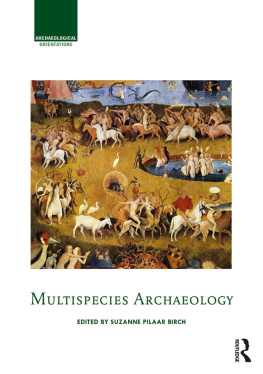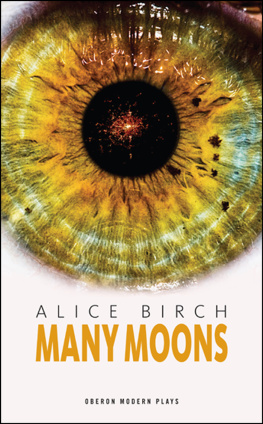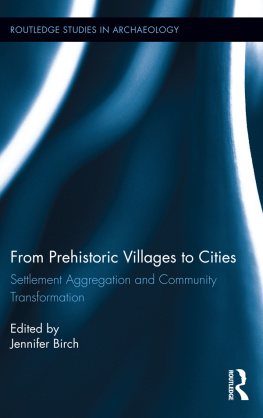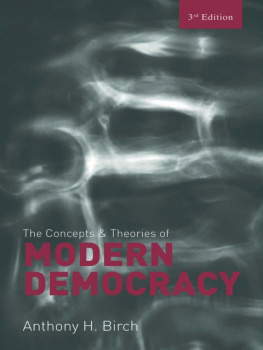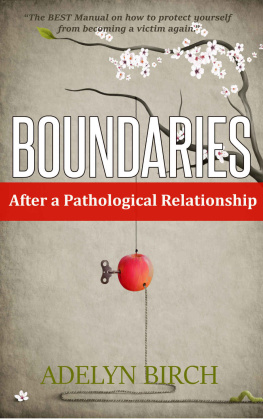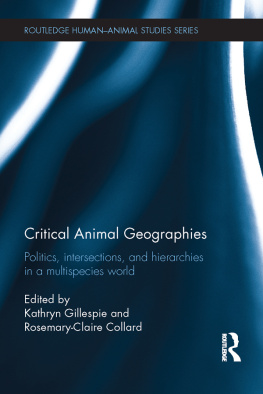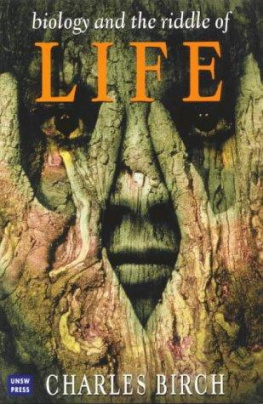Suzanne E. Pilaar Birch - Multispecies Archaeology
Here you can read online Suzanne E. Pilaar Birch - Multispecies Archaeology full text of the book (entire story) in english for free. Download pdf and epub, get meaning, cover and reviews about this ebook. year: 2018, publisher: Routledge, genre: Romance novel. Description of the work, (preface) as well as reviews are available. Best literature library LitArk.com created for fans of good reading and offers a wide selection of genres:
Romance novel
Science fiction
Adventure
Detective
Science
History
Home and family
Prose
Art
Politics
Computer
Non-fiction
Religion
Business
Children
Humor
Choose a favorite category and find really read worthwhile books. Enjoy immersion in the world of imagination, feel the emotions of the characters or learn something new for yourself, make an fascinating discovery.
- Book:Multispecies Archaeology
- Author:
- Publisher:Routledge
- Genre:
- Year:2018
- Rating:4 / 5
- Favourites:Add to favourites
- Your mark:
- 80
- 1
- 2
- 3
- 4
- 5
Multispecies Archaeology: summary, description and annotation
We offer to read an annotation, description, summary or preface (depends on what the author of the book "Multispecies Archaeology" wrote himself). If you haven't found the necessary information about the book — write in the comments, we will try to find it.
Multispecies Archaeology — read online for free the complete book (whole text) full work
Below is the text of the book, divided by pages. System saving the place of the last page read, allows you to conveniently read the book "Multispecies Archaeology" online for free, without having to search again every time where you left off. Put a bookmark, and you can go to the page where you finished reading at any time.
Font size:
Interval:
Bookmark:

p.i
MULTISPECIES ARCHAEOLOGY
Multispecies Archaeology explores the issue of ecological and cultural novelty in the archaeological record from a multispecies perspective. Encompassing more than just our relationships with animals, the book considers what we can learn about the human past without humans as the focus of the question. The volume digs deep into our understanding of interaction with plants, fungi, microbes, and even the fundamental building blocks of life, DNA. Multispecies Archaeology examines what it means to be humanand non-humanfrom a variety of perspectives providing a new lens through which to view the past.
Suzanne E. Pilaar Birch is an Assistant Professor at the University of Georgia with a joint appointment in the departments of Anthropology and Geography. She combines zooarchaeology and biogeochemistry to investigate changes in diet, environment, mobility, and settlement systems spanning the late Pleistocene and early Holocene.
p.ii
ARCHAEOLOGICAL ORIENTATIONS
Series Editors:
Gavin Lucas, University of Iceland, Iceland
Christopher Witmore, Texas Tech University, USA
An interdisciplinary series that engages our ongoing, yet ever-changing, fascination with the archaeological, Archaeological Orientations investigates the myriad ways material pasts are entangled with communities, animals, ecologies and technologies, past, present, or future. From urgent contemporary concerns, including politics, violence, sustainability, ecology, and technology, to long-standing topics of interest, including time, space, materiality, memory and agency, Archaeological Orientations promotes bold thinking and the taking of risks in pressing trans-disciplinary matters of concern.
Published volumes:
Ruin Memories: Materialities, Aesthetics and the Archaeology of the Recent Past
Ed. Bjrnar Olsen, ra Ptursdttir
Elements of Architecture: Assembling Archaeology, Atmosphere and the Performance of Building Spaces
Ed. Mikkel Bille, Tim Flohr Sorensen
Reclaiming Archaeology: Beyond the Tropes of Modernity
Ed. Alfredo Gonzlez-Ruibal
For more information on this series please visit:
https://www.routledge.com/Archaeological-Orientations/book-series/ARCHOR
p.iii
MULTISPECIES
ARCHAEOLOGY
Edited by Suzanne E. Pilaar Birch

p.iv
First published 2018
by Routledge
2 Park Square, Milton Park, Abingdon, Oxon OX14 4RN
and by Routledge
711 Third Avenue, New York, NY 10017
Routledge is an imprint of the Taylor & Francis Group, an informa business
2018 selection and editorial matter, Suzanne E. Pilaar Birch; individual chapters, the contributors
The right of Suzanne E. Pilaar Birch to be identified as the author of the editorial material, and of the authors for their individual chapters, has been asserted in accordance with sections 77 and 78 of the Copyright, Designs and Patents Act 1988.
All rights reserved. No part of this book may be reprinted or reproduced or utilised in any form or by any electronic, mechanical, or other means, now known or hereafter invented, including photocopying and recording, or in any information storage or retrieval system, without permission in writing from the publishers.
Trademark notice : Product or corporate names may be trademarks or registered trademarks, and are used only for identification and explanation without intent to infringe.
British Library Cataloguing-in-Publication Data
A catalogue record for this book is available from the British Library
Library of Congress Cataloging-in-Publication Data
A catalog record has been requested for this book
ISBN: 978-1-138-89898-1 (hbk)
ISBN: 978-1-315-70770-9 (ebk)
Typeset in Bembo
by Swales & Willis Ltd, Exeter, Devon, UK
p.viii
Figures
p.ix
p.x
p.xi
Tables
p.xii
Benjamin Alberti , Department of Sociology, Framingham State University
Oscar Aldred , McCord Centre for Landscape, School of History, Classics and Archaeology, Newcastle University
Brian Boyd , Department of Anthropology, Columbia University
Todd J. Braje , Department of Anthropology, San Diego State University
Kate Britton , 1. Department of Archaeology, University of Aberdeen and 2. Department of Human Evolution, Max Planck Institute for Evolutionary Anthropology
Breana Campbell , Rincon Consultants, Inc., Carlsbad, CA, USA
Molly Crisp , Department of Chemistry, University of York
Ewa Domanska , 1. Department of History, Adam Mickiewicz University and 2. Department of Anthropology, Stanford University
Erich Fisher , 1. Institute of Human Origins, School of Human Evolution and Social Change, Arizona State University and 2. Centre for Coastal Palaeoscience, Nelson Mandela Metropolitan University
Severin Fowles , Department of Anthropology, Barnard College, Columbia University
Noah Heringman , Department of English, University of Missouri
Jamie Hodgkins , Department of Anthropology, University of Colorado Denver
Julia Lee-Thorp , Research Laboratory for Archaeology and the History of Art, University of Oxford
Thomas P. Leppard , McDonald Institute for Archaeological Research, University of Cambridge
Petrus le Roux , Department of Geological Sciences, University of Cape Town
Gavin Lucas , Department of Archaeology, University of Iceland
Michael MacKinnon , Department of Classics, University of Winnipeg
p.xiii
Curtis W. Marean , 1. Institute of Human Origins, School of Human Evolution and Social Change, Arizona State University and 2. Centre for Coastal Palaeoscience, Nelson Mandela Metropolitan University
Nimrod Marom , Zinman Institute of Archaeology, University of Haifa
Terry OConnor , Centre for Human Palaeoecology & Evolutionary Origins, University of York
Kristin Armstrong Oma , Museum of Archaeology, University of Stavanger
Nick J. Overton , Department of Archaeology, University of Manchester
Kirsty Penkman , Department of Chemistry, University of York
ra Ptursdttir , Department of Archaeology and Social Anthropology, University of Troms
Suzanne E. Pilaar Birch , 1. Department of Anthropology, University of Georgia and 2. Department of Geography, University of Georgia
Thomas J. Pluckhahn , Department of Anthropology, University of South Florida, Tampa, Florida
Victor D. Thompson , Department of Anthropology, University of Georgia, Athens
Lior Weissbrod , Zinman Institute of Archaeology, University of Haifa
Laura S. Weyrich , Australian Center for Ancient DNA, University of Adelaide
Stephen G. Whitaker , Channel Islands National Park, Ventura, CA
Christopher Witmore , Department of Classical and Modern Languages and Literatures, Texas Tech University
p.xiv
I would like to thank the series editors, Chris Witmore and Gavin Lucas, for their guidance in the preparation of this edited volume. I would also like to thank the authors for their participation and willingness to contribute to a volume that brings together many disparate perspectives. Thanks also to my editorial assistants at Taylor & Francis, Lola Harre and Molly Marler, for their patience and help.
p.1
Suzanne E. Pilaar Birch
The time is ripe to address the issue of ecological novelty in the archaeological record from a multispecies perspective. Pivotal research topics in archaeology have long simplified ecological noveltyor at least centered it on the humanby framing that novelty as one of many major transitions emphasizing the uniqueness of our species rather than viewing novelty as a collective shift shared amongst multiple species and their habitats. For example, a focus on the origins of art, language, and culture, spread out over tens of thousands of years, are often bundled together as the human revolution, a phrase still popular in paleoanthropology today. Childes (1936) Neolithic Revolution and Urban Revolution in Old World archaeology still loom large, implicitly if not explicitly, as major research foci, as if there is something essential to understanding ourselves emergent in what are regarded as major periods of transition.
Next pageFont size:
Interval:
Bookmark:
Similar books «Multispecies Archaeology»
Look at similar books to Multispecies Archaeology. We have selected literature similar in name and meaning in the hope of providing readers with more options to find new, interesting, not yet read works.
Discussion, reviews of the book Multispecies Archaeology and just readers' own opinions. Leave your comments, write what you think about the work, its meaning or the main characters. Specify what exactly you liked and what you didn't like, and why you think so.

